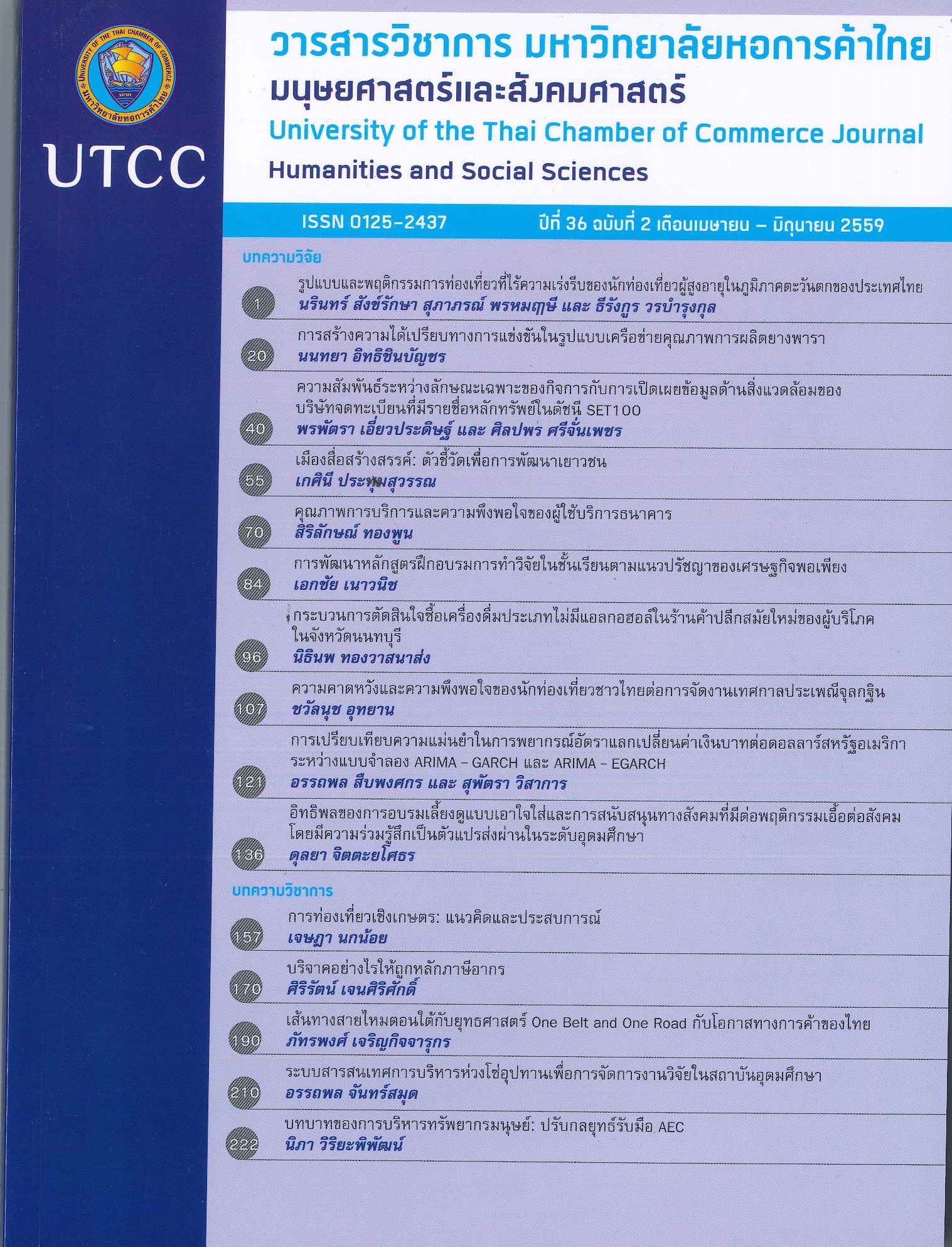การเปรียบเทียบความแม่นยำในการพยากรณ์อัตราแลกเปลี่ยนค่าเงินบาทต่อดอลลาร์สหรัฐอเมริการะหว่าง แบบจำลอง
Main Article Content
บทคัดย่อ
การศึกษานี้มีวัตถุประสงค์เพื่อเลือกแบบจำลองที่เหมาะสมเพื่อนำไปพยากรณ์อัตราแลกเปลี่ยนค่าเงินบาทต่อดอลลาร์สหรัฐ โดยใช้แบบจำลอง ARIMA - GARCH และ ARIMA - EGARCH ซึ่งใช้ข้อมูลอนุกรมเวลารายวันตั้งแต่วันที่ 2 มกราคม พ.ศ. 2549 จนถึง วันที่ 30 กันยายน พ.ศ. 2557 รวมทั้งสิ้น 2,282 วัน ผลการทดสอบ พบว่าข้อมูลอนุกรมเวลามีลักษณะนิ่งที่ระดับ First Difference นอกจากนี้ ผลการพยากรณ์พบว่า แบบจำลองที่มีค่า RMSE และ MAPE ที่ต่ำที่สุด คือ แบบจำลอง ARIMA (2,1,2) with EGARCH (1,1) รองลงมาคือแบบจำลอง ARIMA (2,1,2) with GARCH (1,1) ดังนั้น จึงสรุปได้ว่า แบบจำลอง ARIMA (2,1,2) with EGARCH (1,1) มีความแม่นยำในการพยากรณ์มากที่สุด
Article Details
ลิขสิทธิ์ของบทความ
ผลงานที่ได้รับการตีพิมพ์ถือเป็นลิขสิทธิ์ของมหาวิทยาลัยหอการค้าไทย ห้ามมิให้นำเนื้อหา ทัศนะ หรือข้อคิดเห็นใด ๆ ของผลงานไปทำซ้ำ ดัดแปลง หรือเผยแพร่ ไม่ว่าทั้งหมดหรือบางส่วนโดยไม่ได้รับอนุญาตเป็นลายลักษณ์อักษรจากมหาวิทยาลัยหอการค้าไทยก่อน
เอกสารอ้างอิง
Black, F. 1976. “Studies of Stock Price Volatility Changes.” In Proceedings of the Business and Economics Section of the American Statistical Association, pp. 177–181, Alexandria, V.A: American Statistical Association.
Box, George E. P. and Gwilym M. Jenkins. 1994. Time Series Analysis: Forecasting and Control. Englewood Cliffs, NJ: Prentice – Hall.
Bunditamorn, Chutima. 2009. “Determinants of Exchange Rate Volatility in ASEAN Countries.” An Independent Study Submitted in Partial Fulfillment of the Requirements for the Degree of Master of Economics, Faculty of Economics, Chiang Mai University. (in Thai).
ชุติมา บัณฑิตอมร. 2552. “ปัจจัยที่เป็นตัวกำหนดความผันผวนของอัตราแลกเปลี่ยนในกลุ่มประเทศอาเซียน.” การค้นคว้าแบบอิสระเศรษฐศาสตรมหาบัณฑิต สาขาวิชาเศรษฐศาสตร์ มหาวิทยาลัยเชียงใหม่.
Chaivichayachad, Bundit and Chaivichayachad, Sujit. 2006. “Exchange Rate Regime and the Characteristics of Private Foreign Capital Flows in Thailand.” Applied Economics Journal Kasetsart University 13, 2: 1 – 22. (in Thai).
บัณฑิต ชัยวิชญชาติ และ สุจิต ชัยวิชญชาติ. 2549. “ระบบอัตราแลกเปลี่ยนกับลักษณะของเงินทุนต่างประเทศภาคเอกชนของไทย.” วารสารเศรษฐศาสตร์ประยุกต์ มหาวิทยาลัยเกษตรศาสตร์ 13, 2: 1 – 22.
Champawan, Nontaporn. 2007. “Volatility Estimation for the Exchange Rate of Thailand by ARIMA-GARCH and ARIMA-EGARCH Models.” An Independent Study Submitted in Partial Fulfillment of the Requirements for the Degree of Master of Economics, Faculty of Economics, Chiang Mai University. (in Thai).
นนทพร จำปาวัน. 2550. “การประมาณค่าความผันผวนสำหรับอัตราแลกเปลี่ยนของประเทศไทยโดยแบบจำลองอารีมาการ์ชและแบบจำลองอารีมาอีการ์ช.” การค้นคว้าแบบอิสระเศรษฐศาสตรมหาบัณฑิต สาขาวิชาเศรษฐศาสตร์ มหาวิทยาลัยเชียงใหม่.
Chetchotiros, Sukanya. 2002. “Fluctuation of Exchange Rate on Thai Export.” Master’s Thesis, Faculty of Economics, Ramkhamhaeng University. (in Thai).
สุกัญญา เชษฐโชติรส. 2545. “ความผันผวนในอัตราแลกเปลี่ยนที่มีต่อการส่งออกของประเทศไทย.” วิทยานิพนธ์ปริญญามหาบัณฑิต ภาควิชาเศรษฐศาสตร์ มหาวิทยาลัยรามคำแหง.
Chowvitayangkul, Narumon. 1999. “The Relationship between the Volatilities of Foreign Exchange and Stock Markets.” Master’s Thesis, Faculty of Economics, Chiang Mai University. (in Thai).
นฤมล เชาว์วิทยางกูร. 2542. “ความสัมพันธ์ระหว่างความผันผวนในตลาดแลกเปลี่ยนเงินตราต่างประเทศกับตลาดหลักทรัพย์.” วิทยานิพนธ์ปริญญามหาบัณฑิต สาขาวิชาเศรษฐศาสตร์ มหาวิทยาลัยเชียงใหม่.
Nelson, Daniel B. 1991. “Conditional Heteroscedasticity in Asset Returns: A New Approach” Econometrica 59, 2: 347-370.
Rattanapongpinyo, Taninrat. 2010. “A Study of Factors Affecting the Short-term Movement of the Thai Baht vs the US Dollar.” University of the Thai Chamber of Commerce Journal 30, 1: 1 – 10. (in Thai).
ธนินท์รัฐ รัตนพงศ์ภิญโญ. 2553. “การศึกษาปัจจัยที่มีผลกระทบต่อการเคลื่อนไหวระยะสั้นของอัตราแลกเปลี่ยน ค่าเงินบาทต่อดอลลาร์สหรัฐอเมริกา.” วารสารวิชาการมหาวิทยาลัยหอการค้าไทย 30, 1: 1 – 10.
Rungruang, Dumri. 2000. “Exchange Rate Forecasting Models.” Master’s Thesis, Faculty of Financial Economics, Ramkhamhaeng University. (in Thai).
ดำริห์ รุ่งเรือง. 2543. “แบบจำลองการคาดคะเนอัตราแลกเปลี่ยน.” วิทยานิพนธ์ปริญญามหาบัณฑิต สาขาเศรษฐศาสตร์การเงิน มหาวิทยาลัยรามคำแหง.
Saisriti, Khunchanok. 2006. “Monetary Model Analysis of the Foreign Exchange Rate of Thailand.” Master’s Thesis, Faculty of Economics, Chiang Mai University. (in Thai).
ขวัญชนก สายศรีธิ. 2549. “การวิเคราะห์แบบจำลองทางการเงินของอัตราแลกเปลี่ยนเงินตราต่างประเทศของไทย.” วิทยานิพนธ์ปริญญามหาบัณฑิต สาขาวิชาเศรษฐศาสตร์ มหาวิทยาลัยเชียงใหม่.
Tsay, R.S. 2002. Analysis of Financial Time Series. New York: John Wiley&Sons.


